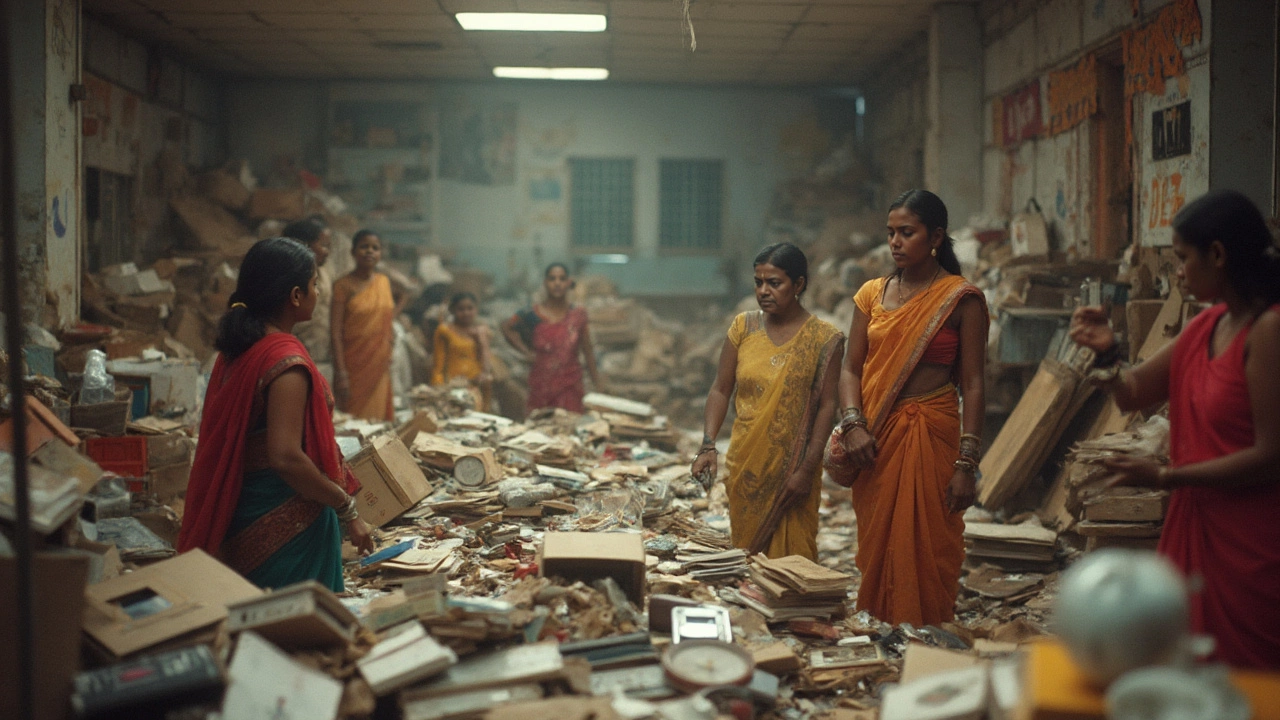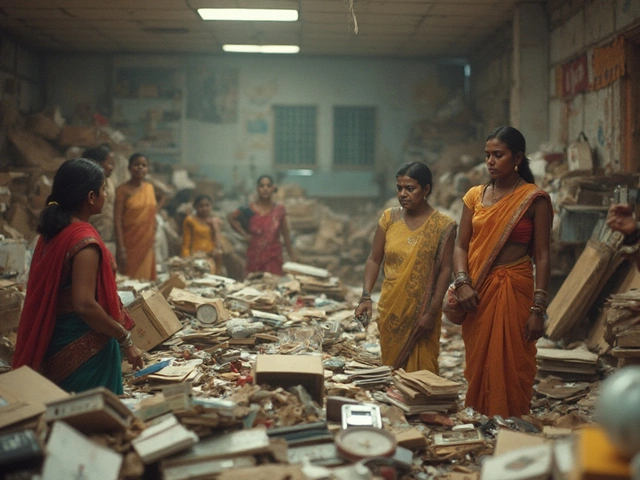At first, the idea of handing over your old stuff to charity feels great. But you’d be surprised at how many donations just end up in the trash, burning up time and money for everyone involved. Some things just can’t be used, either for safety, hygiene, or plain old practicality.
Ever thought about giving that box of leftover paint, half-used lotion bottles, or old mattresses? Most charities actually have to refuse or pay to dispose of those. And then there’s the obvious stuff—broken electronics, ripped clothes, or textbooks from the ‘90s that nobody’s used in years. Believe it or not, even things with the best intentions can turn into a problem if the charity can’t use or resell them.
Saves you closet space, sure. But do you want your donation to actually help, or just push the problem somewhere else? Knowing what not to give is just as important as knowing what to give. Let’s get real about what really happens to those unwanted donations and how you can make sure your generosity lands in the right place.
- Surprising Items Charities Can’t Use
- The Real Cost of Bad Donations
- Smarter Ways to Support Charities
- The Quick Checklist Before You Donate
Surprising Items Charities Can’t Use
Most folks mean well when they fill a box with stuff for charity. But some things charities never want—no matter how much you hope they do. It’s not just about taste or being picky. There are safety codes, legal rules, and simple facts about what can actually help someone in need. Miss that, and your donation could do more harm than good.
Take mattresses and sofas, for example. Tons of charities won’t accept them, because of strict fire-safety laws and the risk of bed bugs or mold. It’s the same with most baby gear—like car seats and cribs. Laws change so fast and safety recalls are so common; most places won’t take the risk.
Open toiletries or any kind of half-used cosmetics are a flat “no.” They can carry germs or just be plain gross to sort through. Even unopened medical supplies usually get turned away. Legal guidelines block charities from passing out prescription drugs and opened packages of things like bandages or syringes.
Then you’ve got the electronics graveyard: old TVs, tube monitors, or clunky printers. E-waste rules get complicated. Most charities can’t afford to fix or recycle that stuff, so it becomes charity donations that cost money, not save it.
Here’s a quick look at stuff most charities put straight on their “sorry, can’t take” list:
- Mattresses, sofas, and padded furniture (especially with stains or rips)
- Baby car seats, cribs, walkers, and strollers older than a few years
- Opened food (unless it’s a food bank with special storage)
- Half-used personal care or cleaning products
- Big kitchen appliances (many thrift stores don’t have the space or outlets to test)
- Big old TV sets or monitors (any kind not flat-screen)
- Broken toys or games with missing parts
- Prescription drugs or expired over-the-counter medicine
- Textbooks more than 5-10 years old
- Damaged clothing (ripped, moldy, or plain worn out)
Some charities share their biggest “problem items” every year. Check out this quick snapshot from a 2024 survey by the National Association of Charity Retailers:
| Top Rejected Donations | % of Charities Reporting Issues |
|---|---|
| Broken furniture | 78% |
| Old TVs/monitors | 73% |
| Mattresses/bed frames | 68% |
| Used car seats/strollers | 65% |
| Opened toiletries/cleaners | 61% |
You don’t want your stuff added to the pile of headaches charities already face. If in doubt, check their website or give them a quick call. Most have a simple “do not donate” list that takes out all the guesswork.
The Real Cost of Bad Donations
Here’s something most people never hear—your charity donations might be costing organizations way more than you’d think. Stuff that can’t be used ends up in landfills or needs extra handling, and charities often have to pay for the hassle. It’s not just about junk taking up space. There’s a real impact on the bottom line.
In the US alone, Goodwill spends tens of millions each year getting rid of stuff it can’t sell. That’s money they could use to feed families or fund job programs, but instead, it’s going to trash fees and hauling services. Some charities even need to hire extra workers just to sift through piles of unwanted goods. And don’t forget the volunteers. They could be spending time helping people, not sorting out stained couches and stacks of old magazines.
Look at these common costs charities face from unusable charity donations:
- Disposal fees: Companies like Salvation Army and Goodwill pay landfill fees just like everyone else. Junk donations lead to thousands of dollars per location, every year.
- Labor hours: More than a quarter of volunteer time at some donation centers gets wasted sorting items that end up in dumpsters.
- Transport costs: Big, bulky items like broken furniture or ancient TVs can cost plenty to haul away.
- Lost resources: Money and time spent on the wrong items means less help for the real needs—food, housing, job training, you name it.
Here’s how it adds up, using real data from US-based charities and thrift stores:
| Charity/Thrift Store | Annual Disposal Cost | Hours Spent Sorting Junk (Per Year) |
|---|---|---|
| Goodwill Industries (US) | $13 million+ | Over 950,000 |
| Salvation Army (US) | $5-7 million | Estimate not published |
| Average Local Thrift Store | $5,000 - $50,000 | 1,000 to 10,000 |
So, while tossing everything into a donation box might feel good, it can actually make life tougher for the people trying to do good. A smart donor asks, “Will this actually help?” before they give. Save your favorite charity from extra headaches—choose what to donate as carefully as if you were giving a gift to a friend.

Smarter Ways to Support Charities
Want your donation to actually help? It’s all about giving what charities can truly use. You don’t have to stick to old clothes or random knick-knacks from the back of your closet. There are much better, more effective ways to support the cause—and make less work for the volunteers sorting through unusable stuff. Here’s what works:
- Cash donations are always the MVP. Nonprofits can use money where it’s needed most, whether that’s buying school supplies, paying rent, or purchasing fresh food in bulk. In fact, the National Philanthropic Trust says nearly 70% of charitable giving in the U.S. is cash or direct funds, because it’s the most flexible.
- Gift cards can be a game-changer for smaller charities. Grocery store or big-box retailer cards let them buy the exact items clients need, especially for things like shoes or personal care products that aren’t returned very often as donations.
- Think seasonal. Shelters and food banks get swamped with coats in summer or flip-flops in December. If you want to give physical stuff, check the charity’s website or call—many list what’s actually in demand, and needs change monthly.
- Bulk basics are gold: new socks, new underwear, and hygiene kits are needed almost everywhere. Buy these items new and in their original packaging. Most charities hand out hygiene kits several times faster than they get restocked by regular donations.
- Volunteer your time if you can't spare cash. Sorting donations, supporting events, or helping with admin work saves charities a bunch in operating costs.
- Host a focused drive: Instead of a general collection, ask your friends or coworkers to donate just one needed item, like school backpacks or packs of diapers. This way, the charity gets exactly what it's short on, without the random junk.
Here's a quick comparison of how different donation types help charities maximize their impact:
| Donation Type | Charity Usefulness | Main Benefit |
|---|---|---|
| Cash | Highest | Flexible, fills biggest needs fast |
| Gift Cards | Very High | Easy for charities to purchase exact items |
| New Essential Goods | High | Direct support, easy distribution |
| Used Clothes (Seasonal/Good Condition) | Medium | Useful if matching specific needs |
| Old Textbooks/Electronics | Low | Often not needed, hard to resell or use |
If you’re ever unsure, call or check the charity's wish list online. They’ll usually tell you flat out what they need—and what causes them headaches. Smart giving makes a real difference, way more than clearing out your garage ever could.
The Quick Checklist Before You Donate
If you're not sure whether your stuff is donation-worthy, you're definitely not alone. Before you load up your trunk, take a minute to run through this simple charity donations checklist. Making this a habit saves everyone time, money, and hassle.
- Is it clean and in good shape? Charities almost never have the resources to wash, mend, or fix your items. Muddy shoes, clothes with holes, or stained bedding usually end up dumped.
- Is it safe and legal? Opened medicine, expired food, and even some baby gear (like car seats past expiration or missing labels) get rejected for safety or legal reasons.
- Does it work? Gadgets, electronics, and kitchen appliances need to turn on and function as expected. No missing parts, no "maybe it works if you jiggle it" deals.
- Is it something the charity actually needs? Check their website or call ahead. Some only take clothing or certain types of furniture, and almost none want bulky CRT TVs or ancient mattresses.
- Is it recent and relevant? Technology, textbooks, and other fast-changing stuff should be less than a few years old for most places.
- Have you checked for a recall? For car seats, cribs, or electronics, a quick search can save everyone a headache if the item's ever been recalled for safety reasons.
Let’s get real: According to the National Association of Charitable Recycling, over 10% of donated goods are so unusable they’re sent straight to landfill, at a removal cost of more than $100 million across the U.S. every year. That’s your donations potentially costing charities, not helping them.
| Item | Usually Accepted? | Common Issues |
|---|---|---|
| Clothes | Yes, if clean and wearable | Stains, rips, strong odors |
| Electronics | Sometimes | Don’t work, outdated |
| Furniture | Yes, select items | Broken, infested, too big |
| Food | Non-perishable only | Expired, homemade, open |
| Baby Gear | Very limited | Recalls, missing info |
The final check? Ask yourself: "Would I want to receive this?" If the answer is no, it's better to recycle or toss it instead. By following this checklist, your charity donations actually help and never get in the way.





